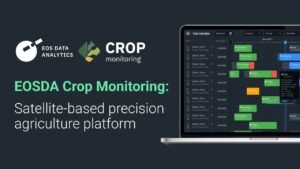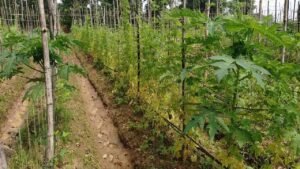Focusing On Crop Types And The Crucial Role Of Monitoring
A crop is a type of plant or animal that is grown for human consumption or financial gain. The term “crop” can also refer to a harvested portion or a processed state, such as shelled or husked produce. It is commonly used in agriculture, horticulture, and aquaculture.
A good understanding of plant different types of crops for high yields is essential in the agriculture industry. Growers can make informed decisions about their plans by gaining knowledge about crop plants and their classification.

Read more: Tips for the high yield papaya farming
Types of Crops by Using
Here are the various types of crops classified according to their use.
Food crops include:
- Cereals (e.g. wheat, rice, barley).
- Seeds (e.g. nuts, legumes).
- Fruits (e.g. apples, berries).
- Vegetables (e.g. high in vitamins A and C).
- Spices (e.g. pepper, ginger).
These plants provide carbohydrates, protein, fiber, healthy fats, vitamins, minerals, and antioxidants for a healthy diet.
Read more: How to use manure in organic Farming?
Plants grown for their use in factories or machines are known as industrial crops, including rubber and tobacco. These crops are utilized to produce various industrial goods, including fiber and fuel products.
Forage crops are crucial for providing animals with the necessary growth nutrients. They are essential for proper pasture management and include important feed options such as alfalfa, barley, maize, millet, oats, sorghum, soybeans, and wheat.
Plants can provide oil that has a multitude of uses. Oil crops rank third in land usage and second in impact on the agricultural economy (second only to cereals). Some crucial plants in this category include soybeans, sunflower seeds, rapeseed, canola, and peanuts. The oil extracted from these plants is utilized for food, fuel, and various industrial purposes.
Ornamental crops are grown for aesthetic value in parks, gardens, and landscape architecture. Common ornamental plants include ivy, oleander, holly, tulips, and azaleas.
Plants grown specifically for their fiber are known as fiber crops. They are utilized to create various products such as clothing, rope, stuffing, and paper. Some well-known crops of this type are cotton, hemp, jute, kenaf, and flax.
Read more: How to Increase crop Yield?
Life Cycle Types of Crops
Perennial crops are plants that can be harvested repeatedly year after year. Such plants include pears, apples, almonds, peaches, walnuts, and hazelnuts. Typically, these plants experience a winter dormancy where they die back to the ground and then regrow in the spring.
Biennial crops refer to plants that complete their life cycle in two years and are treasured for their blooming. In the first year, biennial crops like onions, carrots, cabbages, beets, turnips, and bread-seed poppies grow several decorative leaves near the ground before becoming inactive during colder months.
Annual crops refer to plants that go through their entire life cycle in just one growing season. These plants grow from seeds, mature, and produce flowers and seeds, all within the same season. Examples of such crops include vegetables like tomatoes, radishes, eggplants, peppers, flowers such as calendula and zinnias, and legumes such as beans and peas.
Read more: Hydroponic farming complete information guide.
Most Popular Crops In The World
Corn, also called maize, is a crucial grain crop worldwide. It was first domesticated in Mexico 10,000 years ago and remains culturally and economically important. Many indigenous dishes in Mexico feature corn. Corn is a versatile crop that can be processed into sweeteners, oil, and alcohol, and it contains vital nutrients like carbs, protein, vitamins, and minerals.
Rice is the primary food source for over 3.5 billion people worldwide. Asia is the primary producer and consumer of rice, with China being the largest in the region. Leading global producers include India, Indonesia, Bangladesh, Vietnam, Thailand, Myanmar, and the Philippines. Once rice seeds are harvested, they undergo different milling procedures, resulting in the various types and colors of rice consumed today.
Wheat is the most widely grown crop worldwide, known for its resilience in dry and cold climates. Flour made from wheat is a central component of food products such as bread, pasta, noodles, and breakfast cereals.
Read more: Aeroponic potato farming complete information guide
Cassava is a popular root crop that can grow in harsh conditions. It originated in the Amazon and is now widely harvested in South America and Africa.
Soybean is a protein-rich food that originated in China. This product is ideal for individuals with diabetes and is used for producing soy milk, tofu, and soy sauce. It’s a staple food in Japan and South Korea and is now grown in many countries, including the US, Brazil, and Argentina.

Importance of Crop Monitoring
Monitoring crops to prevent the spread of pests and control diseases and weeds is crucial. However, new threats can arise each year due to mutations and transformations in the biological makeup of these pests. Therefore, avoiding applying the same corrective measures to all problems is essential, as this can lead to severe errors. Monitoring crops is a task that demands great responsibility and should not be underestimated.
One practical and efficient method for progress throughout the growing and harvesting season is to monitor the orchard block and farming lands systematically and visually. This approach can save both time and money.
Read more: How Artificial Intelligence (AI) can help the farmers?
EOS Data Analytics is a global provider of analytical satellite imagery based on artificial intelligence. The company has developed EOSDA Crop Monitoring, an online platform for field monitoring. The solution contains many data types, including crop status, field operations, soil moisture, etc. All of this is on a single platform.
Field monitoring provides timely detection of crop threats, including pests and diseases. Early detection helps farmers save their crops. In addition, decisions on fertilizer and seed application can be made based on plant needs and weather data, resulting in significant savings of inputs and increased field productivity.




